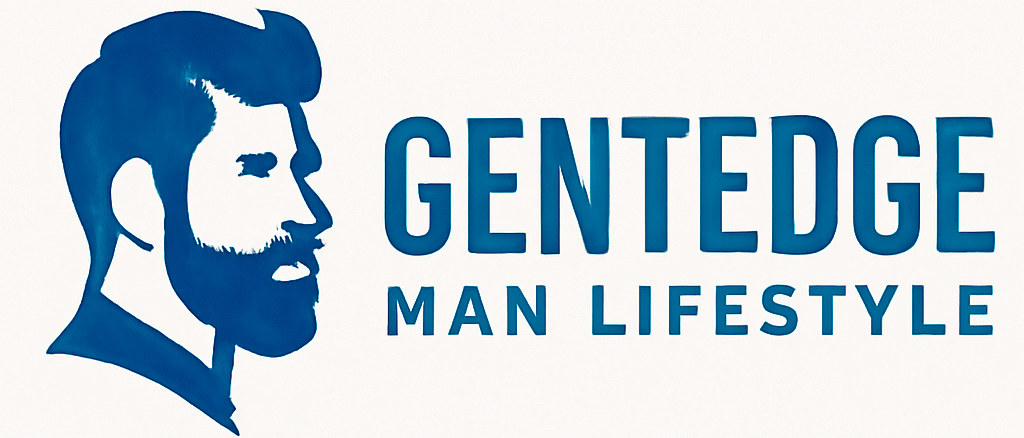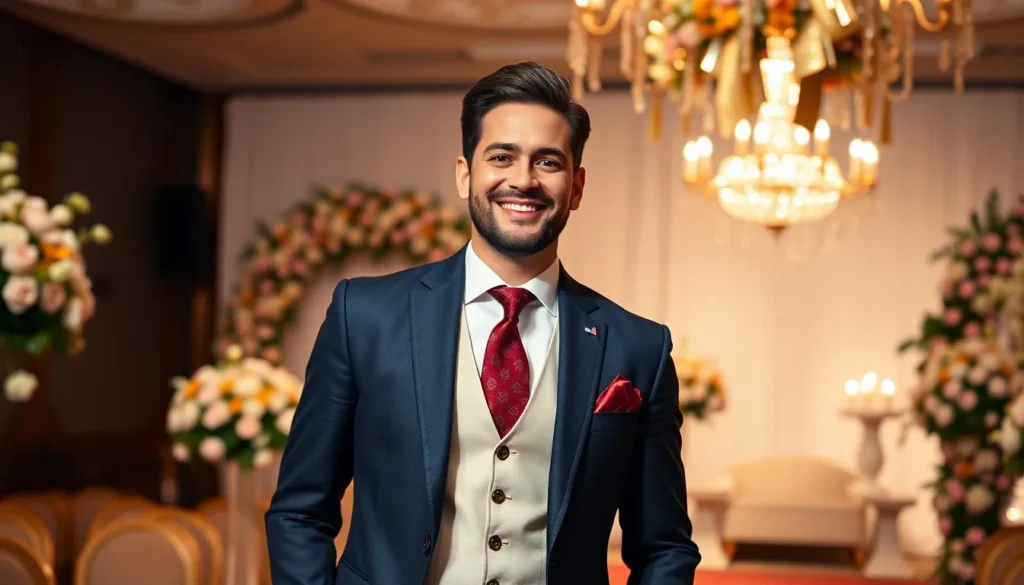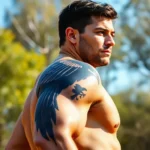Planning your dream wedding means every detail matters – especially what you’ll wear on the most important day of your life. We’ve discovered that Navabi suits for men are revolutionizing wedding fashion with their perfect blend of traditional elegance and contemporary sophistication.
When it comes to wedding attire that’ll make you look absolutely stunning while ensuring comfort throughout your celebration, Navabi suits deliver exactly what modern grooms need. We’re talking about impeccable craftsmanship, luxurious fabrics, and cuts that flatter every body type – because your wedding day deserves nothing less than perfection.
Whether you’re planning a classic ceremony or a modern celebration, we’ll show you why Navabi wedding suits have become the go-to choice for discerning grooms who refuse to compromise on style or quality. Let’s explore how these exceptional suits can transform your wedding day look into something truly unforgettable.
Understanding Navabi Suits: The Perfect Choice for Men’s Wedding Attire
Navabi suits represent a sophisticated blend of heritage and innovation that transforms how we approach men’s wedding fashion. These exceptional garments offer grooms an opportunity to honor tradition while embracing contemporary style sensibilities.
Traditional Origins and Cultural Significance
Navabi suits trace their roots to centuries-old tailoring traditions that originated in South Asian and Middle Eastern cultures. Craftsmen developed these garments using time-honored techniques passed down through generations of master tailors. Traditional navabi suits featured intricate embroidery work, rich silk fabrics, and ceremonial elements that symbolized prosperity and celebration.
Cultural significance runs deep within every navabi suit design, with exact patterns and motifs representing blessings for the marriage. Wedding ceremonies traditionally required formal attire that demonstrated respect for the sacred occasion and honored family heritage. These suits served as more than clothing; they became symbols of commitment and cultural identity.
Regional variations emerged across different communities, each adding unique elements to the basic navabi suit structure. Northern regions favored heavier fabrics and more elaborate decorative work, while coastal areas incorporated lighter materials suited to their climate. Color choices held special meaning, with gold threads representing wealth and burgundy tones symbolizing strength and passion.
Modern Adaptations for Contemporary Weddings
Contemporary navabi suits have evolved to meet the needs of today’s discerning grooms without sacrificing their cultural essence. Modern designers incorporate slim-fit silhouettes, updated color palettes, and refined construction techniques that appeal to contemporary tastes. We see fusion elements that blend traditional navabi features with Western tailoring standards.
Fabric innovations have revolutionized how we experience navabi suits, with lightweight materials offering greater comfort during long wedding celebrations. Designers now use advanced weaving techniques to create fabrics that maintain traditional appearance while providing enhanced breathability and movement. Premium cotton blends, refined silk alternatives, and innovative synthetic materials expand options for different budgets and preferences.
Color variations have expanded beyond traditional options to include modern wedding color schemes. Navy blue navabi suits offer sophisticated elegance, while charcoal gray options provide versatility for various wedding themes. Subtle pattern work and contemporary embellishment techniques create visual interest without overwhelming the overall design aesthetic.
Fit customization has become a hallmark of modern navabi suits, with tailors offering personalized adjustments to ensure perfect proportions. Advanced measuring techniques and multiple fitting sessions guarantee that each suit complements the groom’s exact body type. Custom details like personalized embroidery, unique button selections, and specialized lining options allow for individual expression within traditional frameworks.
Choosing the Right Navabi Suit Style for Your Wedding Day
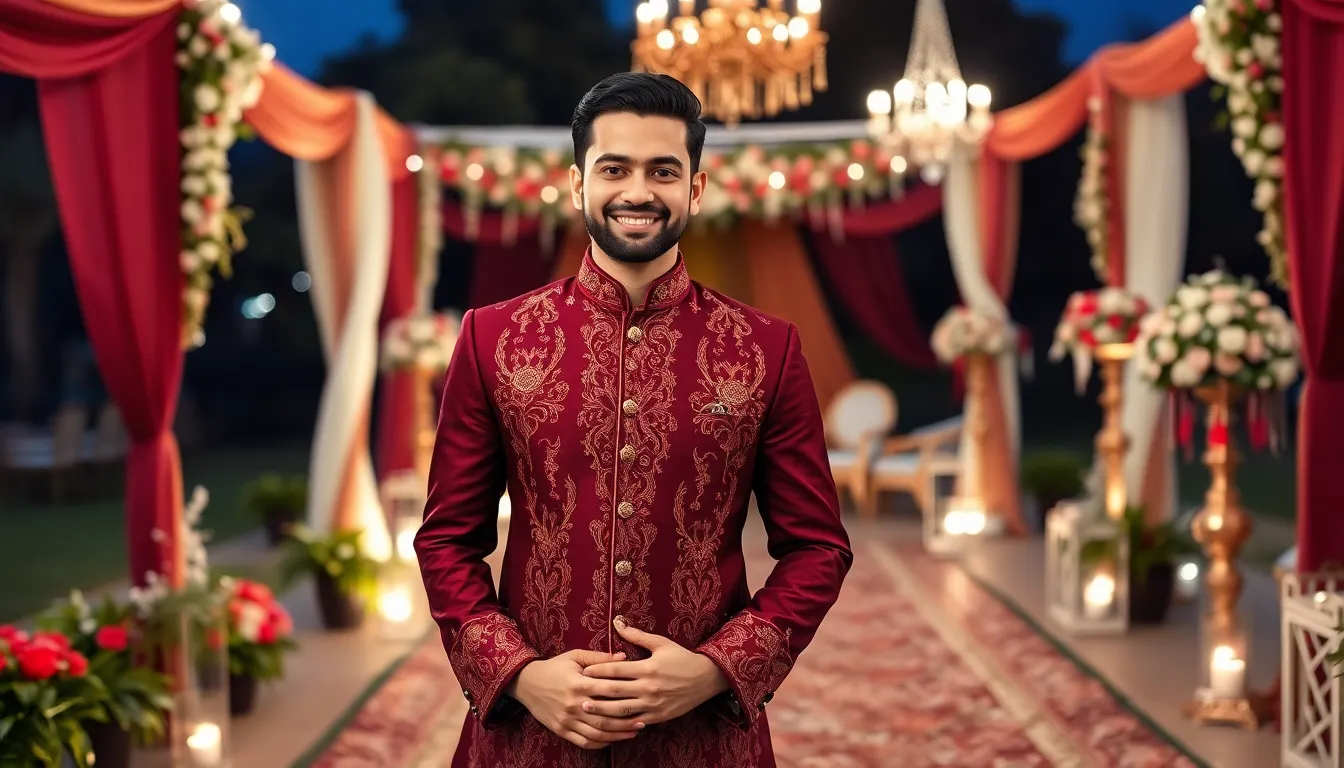
Selecting the perfect Navabi suit style requires understanding your personal preferences and the exact cultural elements you want to honor. We’ll explore three distinct approaches that can transform your wedding day appearance.
Classic Sherwani-Inspired Designs
Classic Navabi suits draw their elegance from traditional sherwani designs, featuring long coat-like garments worn over kurtas and churidar or dhoti pants. Rich fabrics like silk, brocade, velvet jacquard, and heavily embroidered materials form the foundation of these regal pieces. Embellishments including sequin work, stones, and cutdana beaded embroidery create the royal flair that defines authentic Nawabi heritage.
Pairing these suits with silk shawls, printed safa turbans, and gemstone embedded jewelry completes the majestic wedding ensemble. We recommend choosing darker hues like deep maroons or navy blues for evening ceremonies, while golden and cream tones work beautifully for daytime celebrations. The heavy embroidery and ornate details make these suits perfect for main wedding ceremonies where tradition takes center stage.
Contemporary Fusion Styles
Modern Navabi suits blend traditional elements with contemporary tailoring through Indo-Western fusion designs. Bandhgala jackets, Nehru jackets, and stylish sherwanis now feature slimmer cuts and lighter fabrics that prioritize comfort alongside elegance. These updated styles incorporate modern luxury fabrics and refined finishes, making them ideal for receptions and cocktail parties.
Younger generations particularly appreciate these fusion styles because they honor tradition while embracing modernity. We’ve seen growing popularity in pastel color palettes and minimalist embroidery that creates sophisticated elegance without overwhelming ornamentation. The contemporary approach allows for greater versatility across multiple wedding events while maintaining the cultural significance of Navabi heritage.
Regional Variations and Cultural Considerations
Navabi suits vary significantly across different regions, reflecting the unique cultural nuances of various Nawabi legacies from Lucknow, Hyderabad, and Awadh. Some regions favor heavier embroidery and darker color schemes, while others embrace lighter designs and softer tones. The choice of accessories including turbans, footwear, and shawls changes according to exact regional traditions.
Understanding these variations helps preserve cultural respect while personalizing your wedding attire to match family heritage. We suggest consulting with family elders or cultural experts to ensure your suit choice honors the appropriate regional customs. Considering your family’s exact background allows you to create a meaningful connection between your wedding day look and ancestral traditions.
Essential Fabric Options for Men’s Wedding Navabi Suits
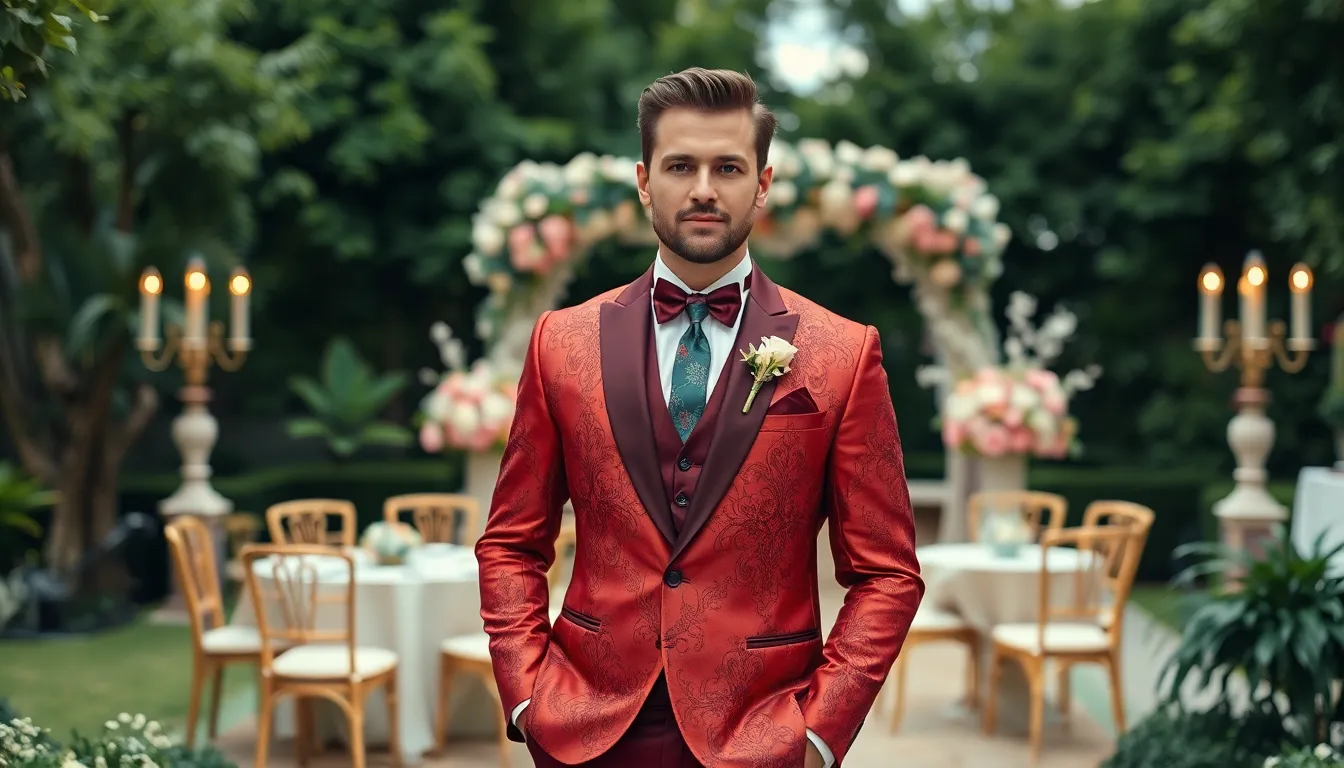
The fabric you choose for your Navabi wedding suit determines both the visual impact and comfort level throughout your special day. Each material offers distinct advantages that can enhance your overall wedding experience.
Luxurious Silk Varieties
Silk remains the gold standard for wedding Navabi suits due to its natural sheen and elegant texture that commands attention. We recommend raw silk and Banarasi silk as the most popular choices, offering an opulent appearance perfect for grooms and close family members. These premium materials showcase intricate embroidery with zari metallic thread or mirror work that enhances the suit’s regal appeal.
Velvet stands as another luxurious option related to silk, providing a plush finish that’s particularly favored for royal-themed weddings. This fabric creates dramatic visual depth while maintaining the sophisticated elegance expected from traditional Navabi attire. The rich texture of velvet complements heavy embellishments beautifully, making it ideal for evening ceremonies where luxury takes center stage.
Elegant Brocade and Jacquard Options
Brocade and jacquard fabrics offer intricate woven patterns that echo traditional Nawabi aesthetics through floral and paisley motifs. These textured materials provide rich visual appeal while maintaining durability throughout long wedding celebrations. We often see these fabrics chosen for sherwani sets and Indo-Western styles, successfully combining heritage elements with modern tailoring techniques.
Their ornate designs make them particularly suitable for indoor or evening weddings where elegance takes priority over breathability. The sophisticated patterns create visual interest without requiring additional embellishments, allowing the fabric itself to serve as the primary decorative element of your Navabi suit.
Comfortable Cotton and Linen Blends
Cotton and linen blends provide breathable alternatives for weddings in warmer climates or outdoor venues without sacrificing style. These lightweight fabrics ensure comfort during lengthy ceremonies and receptions, allowing easy movement while maintaining a refined appearance throughout the celebration.
Linen blends strike an optimal balance between formal structure and casual comfort, making them appropriate for summer weddings where traditional heavy fabrics might cause discomfort. We find these materials particularly valuable for destination weddings or daytime ceremonies where comfort becomes as important as visual appeal in your fabric selection process.
Color Combinations That Make Navabi Suits Wedding-Perfect
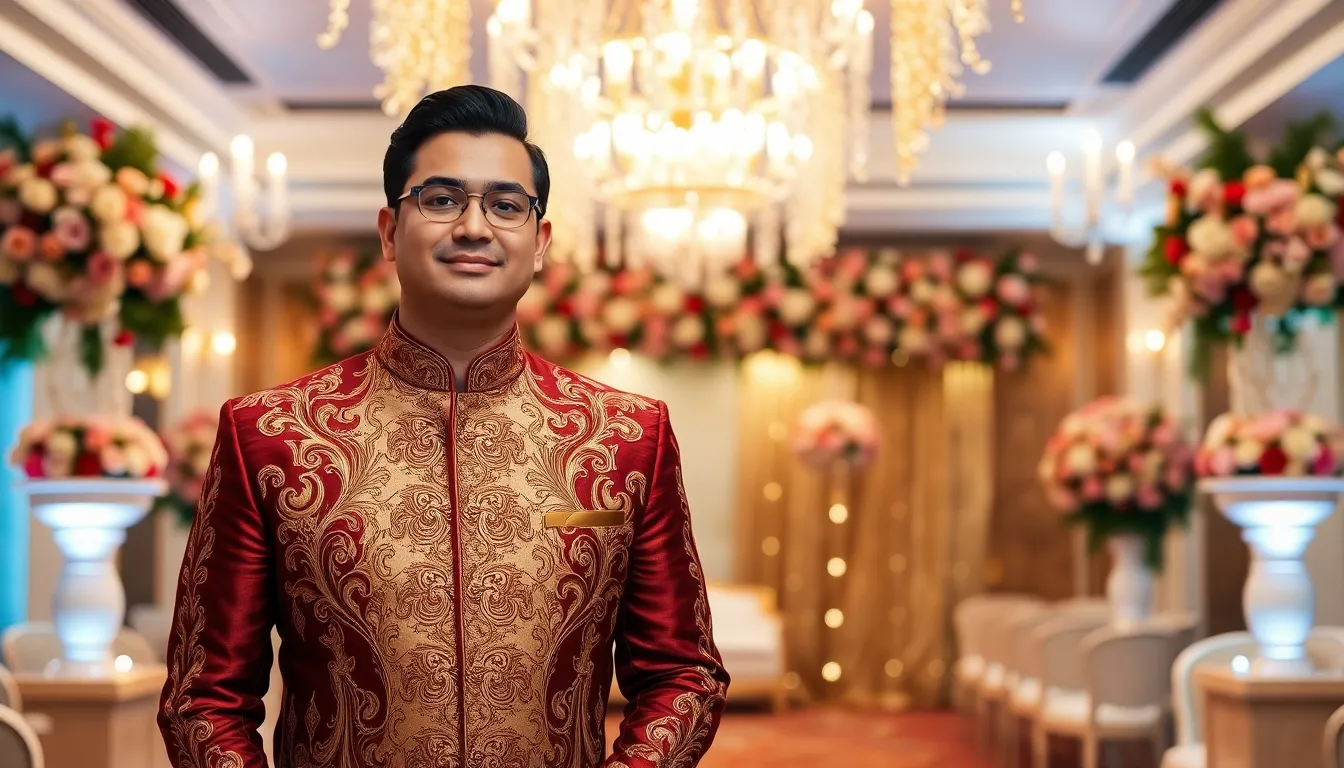
Selecting the perfect color combination elevates your Navabi suit from elegant to extraordinary. These carefully curated color palettes ensure your wedding attire reflects both cultural significance and personal style.
Traditional Gold and Maroon Pairings
Traditional gold and maroon combinations create the most regal appearance for wedding ceremonies. This classic pairing symbolizes prosperity and festivity in South Asian weddings, making it a favorite choice for grooms who want to honor cultural traditions. Gold embroidery on a maroon base delivers maximum visual impact, while maroon detailing on gold fabric offers a more subtle yet equally majestic look.
We recommend this combination for traditional ceremonies where cultural authenticity takes priority. The rich maroon base provides depth while gold accents catch light beautifully during photography sessions. Grooms choosing this palette connect with centuries of wedding traditions while ensuring their attire commands attention at every moment of their celebration.
Modern Neutral Tones
Modern neutral tones offer sophisticated elegance for contemporary wedding styles. Beige, off-white, and soft gray bases paired with elegant embroidery create understated luxury that works beautifully for both day and evening celebrations. These colors provide versatility while maintaining the refined aesthetic that Navabi suits are known for.
Contemporary designers layer these neutral foundations with contrasting elements like bottle green or navy blue for angarkha or bandhgala details. This approach adds visual depth while keeping the overall look sophisticated and modern. We’ve seen grooms successfully wear neutral Navabi suits across different wedding events, from intimate ceremonies to grand receptions.
Bold Statement Colors for Unique Celebrations
Bold statement colors transform Navabi suits into show-stopping wedding attire. Jewel tones like royal blue, deep green, and burgundy offer powerful alternatives for grooms who want their wedding look to make an unforgettable impression. These vibrant colors are trending in modern wedding fashion and create striking visual impact in photographs.
Navy blue tuxedos and suits blend formal western style with traditional Navabi appeal, perfect for contemporary celebrations. Royal blue and deep green options work exceptionally well for evening ceremonies where dramatic lighting enhances these rich hues. We recommend bold colors for grooms who want to express their personality while still honoring the elegance of traditional Navabi styling.
Accessorizing Your Navabi Suit for the Perfect Wedding Look
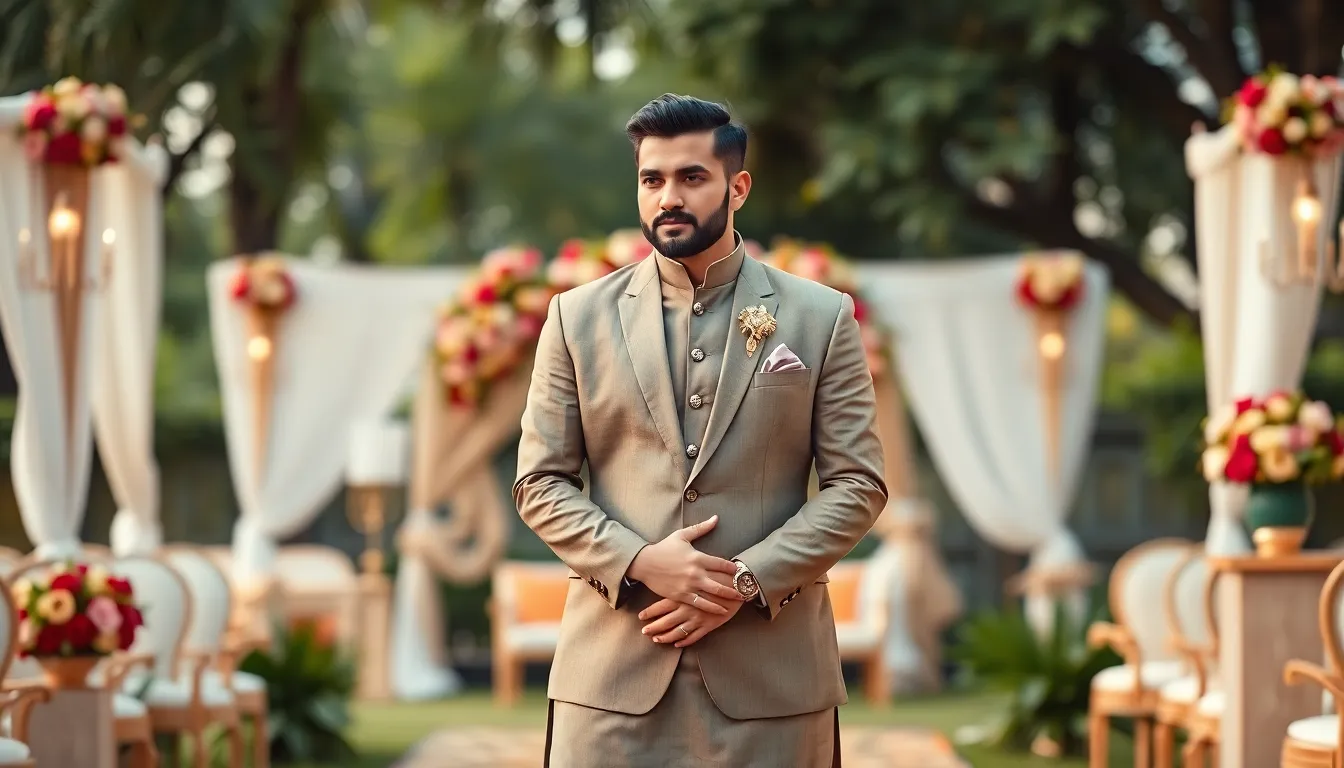
We understand that completing your Navabi suit look requires carefully selected accessories that honor the traditional Nawabi aesthetic while improving your wedding day elegance.
Traditional Jewelry and Ornaments
Brooches and lapel pins serve as the cornerstone of traditional Navabi suit jewelry, adding regal sophistication to your ensemble. We recommend selecting pieces crafted with pearls or gemstones that complement your suit’s color palette and embroidery details.
Pearl or gemstone necklaces create an aristocratic appearance that’s deeply rooted in Nawabi tradition. These statement pieces work exceptionally well with high-necked sherwanis or traditional collar styles.
Turbans or safa with decorative elements complete the noble aesthetic we’re aiming for in Navabi wedding attire. Adding brooches or feathers to your headwear creates visual continuity with your suit’s embellishments while maintaining cultural authenticity.
Pocket watches on chains offer another traditional option that speaks to the era’s refinement. These functional accessories add vintage charm while staying true to the Nawabi theme of understated luxury.
Footwear Options That Complement the Style
Mojari shoes represent the most authentic footwear choice for your Navabi suit ensemble. These handcrafted leather shoes feature intricate embroidery that mirrors the detailed work on traditional Nawabi garments.
Jutti footwear provides another excellent option with its closed-toe design and decorative elements. We find these shoes particularly comfortable for extended wedding celebrations while maintaining the cultural integrity of your look.
Embellished leather styles work beautifully when they incorporate similar color tones or metallic threads found in your suit’s embroidery. This coordination creates a cohesive appearance that’s both sophisticated and culturally appropriate.
Traditional craftsmanship in these footwear options ensures you’re supporting authentic artisan work while achieving the perfect complement to your Navabi suit’s historical significance.
Essential Accessories for Complete Ensemble
Embroidered stoles or shawls draped elegantly over one shoulder add layers of texture and cultural richness to your wedding look. We suggest selecting pieces that feature complementary embroidery patterns without overwhelming your suit’s primary design elements.
Pocket squares should match your suit’s color palette while adding subtle visual interest to your jacket. These small details demonstrate attention to the refined aesthetic that defines Nawabi style.
Cufflinks reflecting luxury enhance your ensemble’s overall opulence through carefully chosen metals and gemstones. We recommend pieces that echo the metallic threads or beadwork found in your suit’s embroidery.
Subtle jewelry additions like rings or watches contribute sophisticated touches without overpowering the traditional elements. These contemporary accessories bridge the gap between historical authenticity and modern wedding expectations.
Coordinated color schemes across all accessories ensure your complete ensemble reflects the polished elegance expected in Nawabi wedding attire. This thoughtful approach creates the distinguished look that makes your special day truly memorable.
Tailoring and Fit Considerations for Wedding Navabi Suits
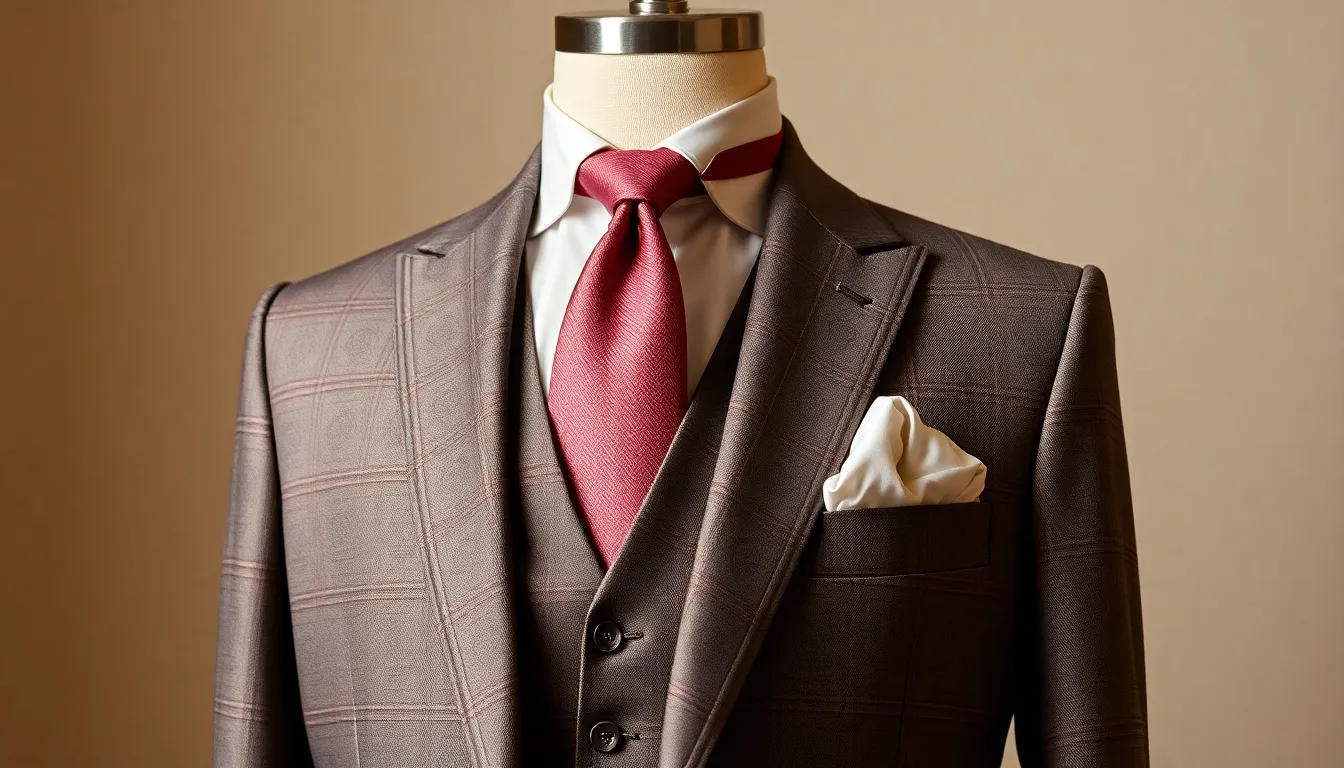
Achieving the perfect fit for your wedding Navabi suit requires careful planning and attention to detail. Expert tailoring transforms a beautiful suit into a masterpiece that complements your body and enhances your confidence on your special day.
Finding the Right Measurements
Precise body measurements form the foundation of any well-fitted Navabi suit. We recommend measuring six key areas: chest, waist, hips, shoulders, arm length, and inseam. Professional tailors use these measurements to ensure your suit flatters your natural silhouette while maintaining the traditional elegance of Navabi styling.
Shoulder width deserves special attention since jacket shoulders are extremely difficult to alter. Selecting a suit with correct shoulder measurements from the start saves you from costly adjustments later. This critical measurement determines how the entire jacket will drape on your frame.
Choosing a base size that closely matches your measurements minimizes extensive tailoring work. We suggest working with experienced tailors who understand Navabi suit construction to identify the ideal starting point for your alterations.
Customization Options for Personal Style
Tailoring details allow you to personalize your Navabi suit while honoring traditional aesthetics. Popular customization options include jacket cut variations like slim, modern, or customized fit, along with pant tapering, lapel style modifications, and fabric weight adjustments that suit your wedding theme.
Fabric selection should align with your wedding season and venue. Heavier fabrics such as wool or velvet work beautifully for winter weddings, while lighter materials complement summer or beach ceremonies. This seasonal consideration ensures both comfort and appropriate styling.
Color coordination with your wedding palette creates visual harmony throughout your celebration. Darker tones provide a slimming effect and work well for formal evening ceremonies, while lighter shades suit warm weather celebrations and daytime events.
Timeline for Alterations and Fittings
Beginning fittings 4 to 6 weeks before your wedding provides adequate time for multiple alteration sessions. This timeline allows for unexpected adjustments and ensures your suit achieves the perfect fit without rushing the tailoring process.
Pants alterations like hemming and tapering are straightforward procedures that most skilled tailors can complete easily. Jacket modifications require more expertise and should focus on waist and sleeve adjustments while avoiding complex shoulder and armhole changes.
Scheduling your final fitting 1 to 2 weeks before the wedding perfects your suit’s fit and comfort. This appointment ensures complete ease of movement without compromising the sophisticated style that makes Navabi suits so distinguished for wedding celebrations.
Where to Shop for Quality Men’s Wedding Navabi Suits

Finding the perfect Navabi suit requires knowing where to look for authentic craftsmanship and quality materials. We’ll explore the best shopping destinations that offer everything from traditional handcrafted pieces to modern interpretations of this regal wedding attire.
Specialized Ethnic Wear Boutiques
Specialized ethnic boutiques provide the most authentic Navabi suit experience with their focus on traditional craftsmanship and cultural accuracy. Boutiques like Shreeman offer exclusive collections of Indo-Western wedding attire featuring handcrafted suits made from premium fabrics such as Banarasi silk, brocade, jacquard, and velvet with intricate embroidery work. These establishments typically stock vibrant traditional colors including gold, red, black, and blue that honor the royal Nawabi heritage.
Expert tailors at these boutiques understand the cultural significance of each design element and can guide you through selecting appropriate styles for your ceremony. Many ethnic wear specialists maintain relationships with skilled artisans who create custom embellishments and detailed embroidery work that mass market retailers can’t match. Staff members often possess deep knowledge about regional variations and can help you choose designs that reflect your family’s cultural background.
Online Retailers and Custom Tailoring Services
Online platforms have revolutionized access to quality Navabi suits by connecting customers with skilled tailors worldwide. Etsy serves as a marketplace where custom tailors offer made to measure Nawabi suits with personalized fitting consultations and detailed craftsmanship. Customer reviews on these platforms consistently praise the fit and quality of custom made suits, though buyers should account for extended shipping times due to international customs clearance processes.
Pinterest provides valuable inspiration for finding suitable Navabi sherwani and suit designs through curated collections and linked retailers. Digital platforms allow you to compare styles, read authentic customer feedback, and communicate directly with tailors about exact customization requests. Online custom tailoring services often provide detailed measurement guides and virtual consultations to ensure proper fit without in person visits.
Budget-Friendly Options Without Compromising Quality
Budget conscious grooms can find quality Navabi suits through strategic shopping without sacrificing style or cultural authenticity. Clearance sales at ethnic boutiques often feature previous season designs at significantly reduced prices while maintaining the same quality standards and craftsmanship. Lesser known online retailers frequently offer competitive pricing on Navabi suits with decent quality materials and proper tailoring techniques.
End of season sales and festival clearances provide opportunities to purchase premium fabrics and detailed embroidery work at fraction of regular costs. But, we recommend carefully verifying material quality, stitching standards, and return policies before making budget purchases. Some emerging designers offer contemporary Navabi interpretations at accessible price points while maintaining cultural integrity and modern fit standards.
Styling Tips for Different Wedding Ceremonies and Events
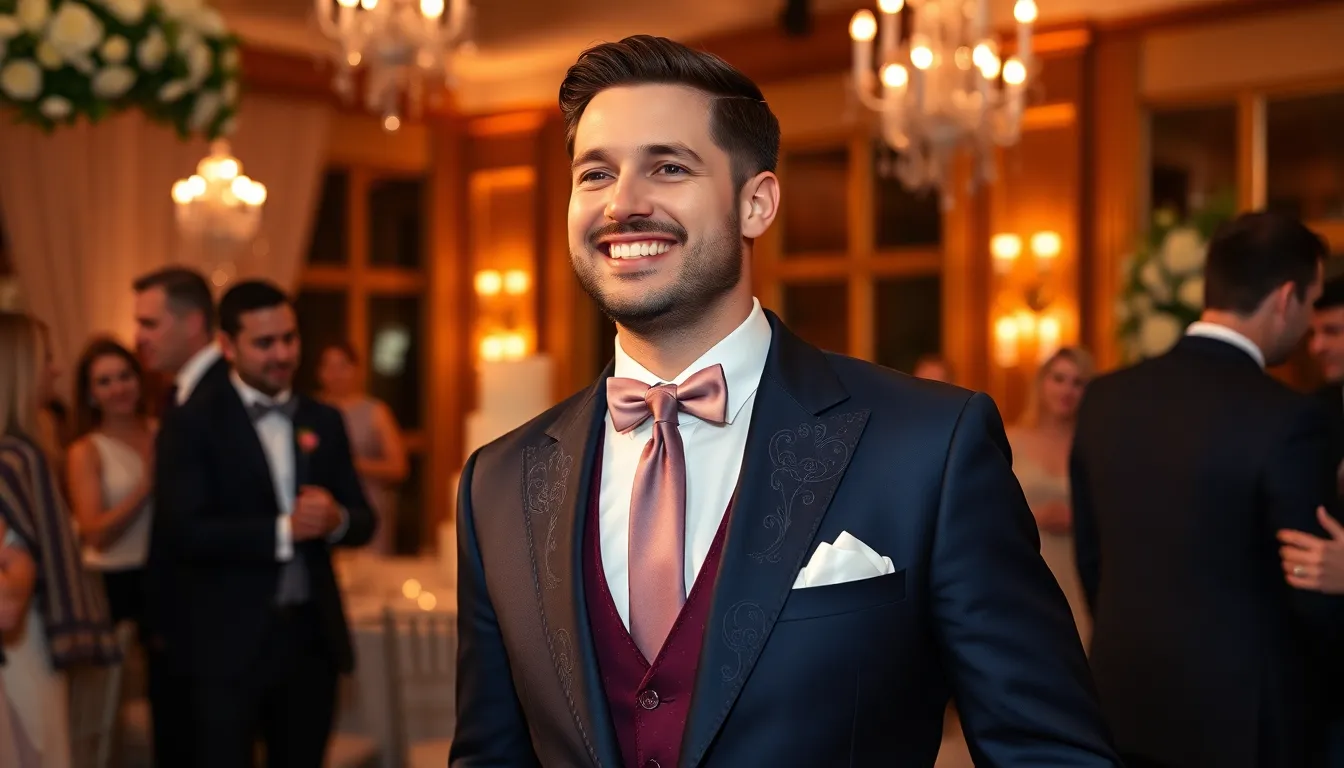
Every wedding celebration requires a distinct approach to styling your Navabi suit. We’ll guide you through the perfect looks for each stage of your special festivities.
Engagement and Pre-Wedding Functions
Choose lighter shades and pastel tones for engagement ceremonies to create a fresh and elegant appearance that sets the perfect tone for your upcoming nuptials. Silk or lightweight cotton fabrics work exceptionally well for daytime or outdoor events, providing comfort while preserving that sophisticated style we all desire.
Keep accessories minimal during pre-wedding functions by selecting simple pocket squares or subtle cufflinks that maintain a semi-formal vibe. This approach allows your natural charisma to shine through without overwhelming the intimate nature of these preliminary celebrations.
Opt for breathable fabrics that’ll keep you comfortable during longer engagement parties or mehendi ceremonies. Cotton blends and lightweight silk varieties ensure you stay cool while looking impeccably dressed throughout these joyous occasions.
Main Wedding Ceremony Looks
Select grandiose Navabi suits with intricate embroidery or rich detailing for the main wedding ceremony, as this moment demands your most spectacular appearance. Velvet or silk fabrics in deep, regal colors such as maroon, navy, or emerald green elevate your presence and command attention from every guest.
Accessorize with classic traditional items like brooches, turbans, or decorative sashes to emphasize the royal aspects of the Navabi style. These elements connect you to centuries of cultural heritage while creating a truly majestic wedding day look.
Ensure perfect tailoring by confirming that shoulder seams align precisely with your shoulders, sleeves fall just past your wrists, and trousers rest neatly on your shoes for a polished appearance. This attention to fit details transforms a beautiful suit into an extraordinary statement piece.
Complete the ensemble with traditional footwear like mojaris or juttis that honor cultural authenticity while providing comfort for your ceremony. These handcrafted shoes perfectly complement the Navabi aesthetic and ensure you’re appropriately dressed from head to toe.
Reception and Post-Wedding Celebrations
Experiment with modern cuts and Indo-Western fusion elements during post-wedding events, as these celebrations allow for more creative styling choices. Contemporary interpretations of traditional Navabi suits blend heritage with innovation perfectly.
Select lighter fabrics such as cotton or blends that offer superior comfort for longer reception celebrations where you’ll be dancing and socializing extensively. Evening receptions suit darker and richer hues, so velvet Navabi suits in royal colors provide a striking and sophisticated look.
Add playful accessories like colored pocket squares or stylish wristwatches to introduce contemporary twists to your traditional ensemble. This modern approach keeps your look fresh while maintaining respect for cultural traditions.
Coordinate your suit colors with the wedding theme to create a cohesive aesthetic that photographs beautifully and impresses your guests throughout the celebration.
Caring for Your Navabi Suit Investment
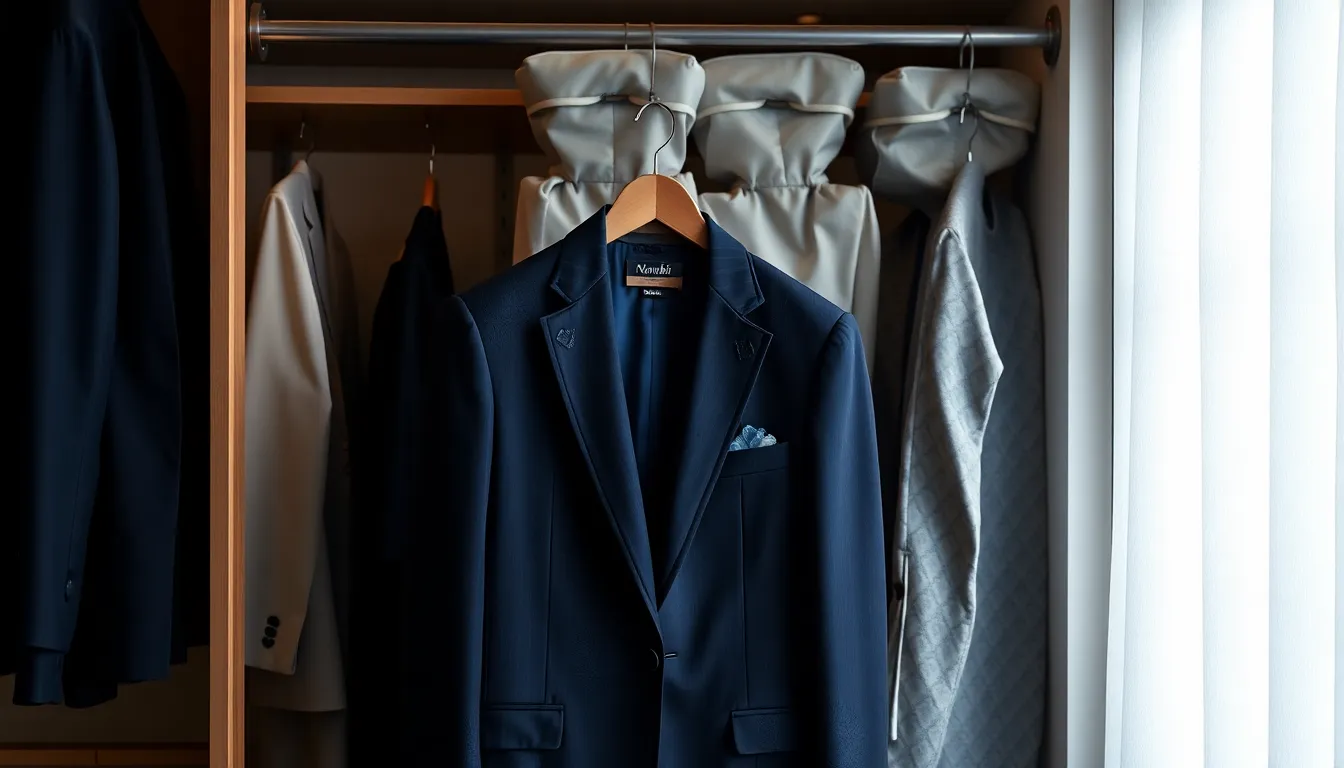
Your wedding Navabi suit represents a important investment in both style and cultural heritage. Proper care ensures this treasured garment maintains its elegance for years to come.
Proper Storage Techniques
Garment bags protect your Navabi suit from dust and environmental damage. We recommend investing in a breathable fabric cover that allows air circulation while shielding the delicate embroidery from potential snags. Cedar hangers work best for maintaining the suit’s shape, as metal hangers can cause unwanted creases and fabric stretching over time.
Hanging your suit immediately after wearing prevents permanent wrinkles. Allow the garment to air out completely before placing it in storage. Choose a cool, dry closet space away from direct sunlight, which can fade intricate thread work and rich fabric colors that make Navabi suits so distinctive.
Folding should be avoided whenever possible for embellished pieces. The weight of embroidery and beadwork can create permanent creases when stored flat. If hanging isn’t an option, wrap the suit in acid free tissue paper and store it in a large, flat box.
Professional Cleaning and Maintenance
Check the care label before attempting any cleaning method. Most Navabi suits require dry cleaning due to their delicate fabrics and intricate embellishments. We suggest finding a cleaner experienced with ethnic wear, as they understand the special handling requirements for silk, brocade, and heavily embroidered pieces.
Avoid over cleaning, which can damage delicate fibers and fade colors. Professional cleaning should only occur when absolutely necessary, typically after 3 to 4 wears or when visible stains appear. Between cleanings, use a soft bristled brush to gently remove surface dust and lint from the fabric.
Steam treatment works better than traditional pressing for wrinkle removal. Professional cleaners use specialized equipment that protects embroidery and beadwork while smoothing the fabric. Request that your cleaner avoid harsh chemicals on metallic threads, which can tarnish or break with aggressive treatment.
Long-Term Preservation Tips
Air circulation prevents musty odors and fabric deterioration. We recommend removing your Navabi suit from storage every few months to allow fresh air to reach all areas of the garment. This practice also gives you an opportunity to inspect for any signs of damage or pest activity.
Avoid frequent washing to preserve the fabric’s integrity and color vibrancy. Spot cleaning minor stains immediately prevents them from setting and requiring professional intervention. Use a clean, damp cloth to gently dab at spills rather than rubbing, which can spread the stain or damage embroidery.
Minimize exposure to moisture and extreme temperatures. Store your suit in a climate controlled environment where humidity levels remain stable. Basements and attics can cause mold growth or fabric brittleness that permanently damages your investment piece.
Conclusion
Your wedding day deserves nothing less than perfection and a Navabi suit delivers exactly that. We’ve explored how these magnificent garments seamlessly blend centuries-old traditions with contemporary style making them the ideal choice for today’s discerning groom.
From selecting the perfect fabric and color combination to ensuring impeccable tailoring and thoughtful accessorizing every detail contributes to creating your unforgettable wedding look. The investment you make in a quality Navabi suit extends far beyond your special day – with proper care it becomes a treasured heirloom that carries your cultural heritage forward.
We encourage you to embrace this timeless elegance and make your wedding celebration truly memorable. Your Navabi suit isn’t just wedding attire – it’s a statement of sophistication tradition and personal style that will make you feel like royalty on the most important day of your life.
Frequently Asked Questions
What makes Navabi suits special for weddings?
Navabi suits combine traditional elegance with contemporary sophistication, offering impeccable craftsmanship, luxurious fabrics, and flattering cuts. They carry deep cultural significance from South Asian and Middle Eastern traditions, featuring intricate designs that symbolize prosperity and commitment, making them perfect for modern grooms who value both style and heritage.
What are the best fabric choices for men’s wedding Navabi suits?
The top fabric options include luxurious silk varieties like raw silk and Banarasi silk for opulent appearance, velvet for royal-themed weddings, elegant brocade and jacquard for traditional aesthetics, and comfortable cotton-linen blends for warmer climates. Each fabric offers different benefits in terms of visual appeal and comfort.
How do I choose the right Navabi suit style for my wedding?
Consider three main approaches: classic sherwani-inspired designs with heavy embroidery for traditional ceremonies, contemporary fusion styles blending traditional and modern elements for receptions, and regional variations reflecting specific cultural nuances. Consult family elders or cultural experts to ensure your choice honors regional customs and traditions.
What color combinations work best for wedding Navabi suits?
Traditional gold and maroon pairings symbolize prosperity and are ideal for cultural ceremonies. Modern neutral tones like beige and soft gray offer sophisticated elegance, while bold colors such as royal blue and deep green create striking impressions. Choose colors that complement your wedding theme and personal style.
How should I accessorize my Navabi suit?
Essential accessories include traditional jewelry like brooches and pearl necklaces, turbans or safa for regal appeal, authentic footwear like mojari shoes, embroidered stoles, pocket squares, and cufflinks. Ensure all accessories follow a coordinated color scheme to create a cohesive, polished appearance that respects cultural heritage.
When should I start getting my Navabi suit tailored?
Begin fittings 4 to 6 weeks before your wedding to allow for multiple alterations. Schedule your final fitting 1 to 2 weeks prior to the event. This timeline ensures proper customization while maintaining traditional aesthetics and allows for any necessary adjustments to achieve the perfect fit.
Where can I buy quality men’s wedding Navabi suits?
Specialized ethnic wear boutiques offer authentic craftsmanship and premium materials. Online retailers and custom tailoring services provide personalized fitting consultations. For budget-conscious options, explore clearance sales and lesser-known online retailers, but always verify material quality and return policies before purchasing.
How do I properly care for my Navabi suit?
Store in breathable garment bags using cedar hangers to maintain shape. Avoid folding embellished pieces and use professional cleaning services due to delicate fabrics and intricate embellishments. Ensure proper air circulation and minimize exposure to moisture and extreme temperatures for long-term preservation.
